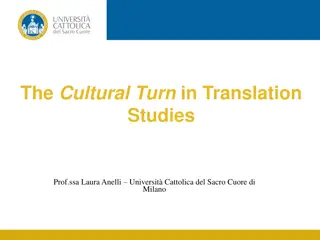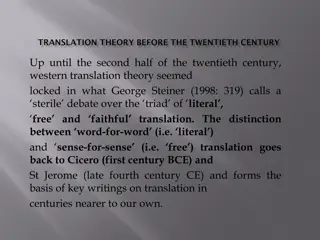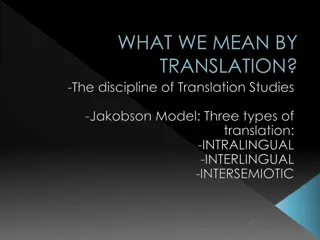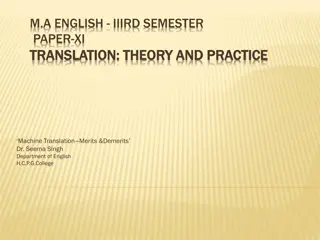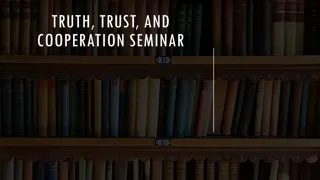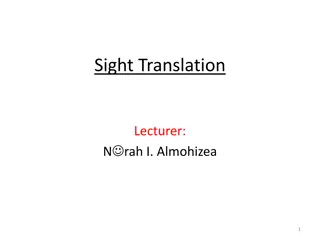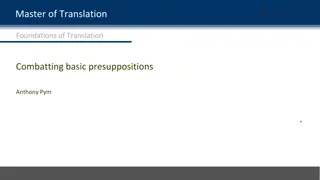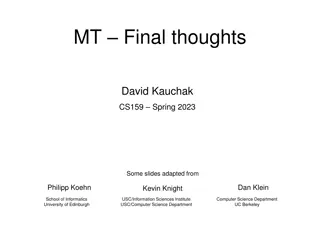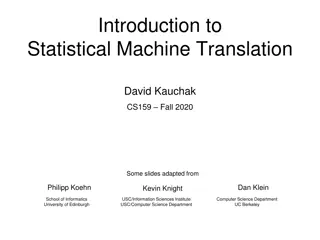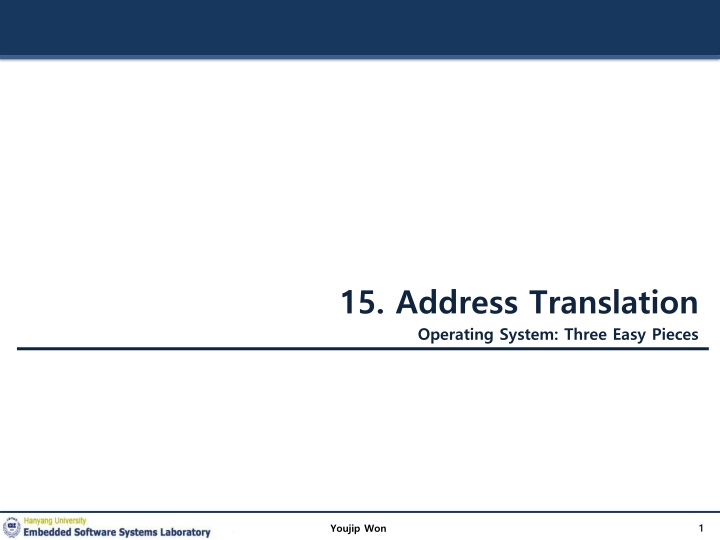
Memory Virtualization and Address Translation in Operating Systems
Discover how memory virtualization and address translation play vital roles in operating systems, ensuring efficient storage and retrieval of data through hardware support and key OS interventions.
Download Presentation

Please find below an Image/Link to download the presentation.
The content on the website is provided AS IS for your information and personal use only. It may not be sold, licensed, or shared on other websites without obtaining consent from the author. If you encounter any issues during the download, it is possible that the publisher has removed the file from their server.
You are allowed to download the files provided on this website for personal or commercial use, subject to the condition that they are used lawfully. All files are the property of their respective owners.
The content on the website is provided AS IS for your information and personal use only. It may not be sold, licensed, or shared on other websites without obtaining consent from the author.
E N D
Presentation Transcript
15. Address Translation Operating System: Three Easy Pieces 1 Youjip Won
Memory Virtualizing with Efficiency and Control Memory virtualizing takes a similar strategy known as limited direct execution(LDE) for efficiency and control. In memory virtualizing, efficiency and control are attained by hardware support. e.g., registers, TLB(Translation Look-aside Buffer)s, page-table 2 Youjip Won
Address Translation Hardware transforms a virtual address to a physical address. The desired information is actually stored in a physical address. The OS must get involved at key points to set up the hardware. The OS must manage memory to judiciously intervene. 3 Youjip Won
Example: Address Translation C - Language code void func() int x; ... x = x + 3; // this is the line of code we are interested in Load a value from memory Increment it by three Store the value back into memory 4 Youjip Won
Example: Address Translation(Cont.) Assembly 128 : movl 0x0(%ebx), %eax 132 : addl $0x03, %eax 135 : movl %eax, 0x0(%ebx) ; load 0+ebx into eax ; add 3 to eax register ; store eax back to mem Presume that the address of x has been place in ebx register. Load the value at that address into eax register. Add 3 to eax register. Store the value in eax back into memory. 5 Youjip Won
Example: Address Translation(Cont.) 0KB Fetch instruction at address 128 128 132 135 movl 0x0(%ebx),%eax Addl 0x03,%eax movl %eax,0x0(%ebx) 1KB Execute this instruction (load from address 15KB) Program Code 2KB Fetch instruction at address 132 3KB Heap Execute this instruction (no memory reference) 4KB Fetch the instruction at address 135 heap Execute this instruction (store to address 15 KB) (free) stack 14KB 15KB 3000 Stack 16KB 6 Youjip Won
Relocation Address Space The OS wants to place the process somewhere else in physical memory, not at address 0. The address space start at address 0. 7 Youjip Won
A Single Relocated Process 0KB 0KB Program Code Operating System 16KB Heap (not in use) 32KB Code Heap Relocated Process heap (allocated but not in use) (free) Stack 48KB stack (not in use) Stack 64KB 16KB Physical Memory Address Space 8 Youjip Won
Base and Bounds Register 0KB 0KB Program Code Operating System 16KB Heap (not in use) base register 32KB 32KB Code Heap heap (allocated but not in use) (free) Stack 48KB stack (not in use) Stack bounds register 64KB Physical Memory 16KB 16KB Address Space 9 Youjip Won
Dynamic(Hardware base) Relocation When a program starts running, the OS decides where in physical memory a process should be loaded. Set the base register a value. ? ???? ??????? = ??????? ??????? + ???? Every virtual address must not be greater than bound and negative. 0 ??????? ?????????????? ??????? < ?????? 10 Youjip Won
Relocation and Address Translation 0KB 128 132 135 movl 0x0(%ebx),%eax Addl 0x03,%eax movl %eax,0x0(%ebx) 128 : movl 0x0(%ebx), %eax 1KB Program Code 2KB Fetch instruction at address 128 3KB Heap 32896 = 128 + 32??(????) 4KB Execute this instruction heap Load from address 15KB (free) 47?? = 15?? + 32??(????) stack 14KB 15KB 3000 Stack 16KB 11 Youjip Won
Two ways of Bounds Register 0KB 0KB Program Code Operating System 16KB Heap (not in use) 32KB Code Heap ???????? ??????? ?? ??? ??? ?? ??????? ????? ??? ???? ?? ??????? ?????? (allocated but not in use) (free) bounds bounds Stack 48KB 16KB 48KB (not in use) Stack 64KB Physical Memory 16KB Address Space 12 Youjip Won
OS Issues for Memory Virtualizing The OS must take action to implement base-and-bounds approach. Three critical junctures: When a process starts running: Finding space for address space in physical memory When a process is terminated: Reclaiming the memory for use When context switch occurs: Saving and storing the base-and-bounds pair 13 Youjip Won
OS Issues: When a Process Starts Running The OS must find a room for a new address space. free list : A list of the range of the physical memory which are not in use. 0KB Operating System The OS lookup the free list 16KB Free list (not in use) 32KB 16KB Code Heap (allocated but not in use) Stack 48KB 48KB (not in use) 64KB Physical Memory 14 Youjip Won
OS Issues: When a Process Is Terminated The OS must put the memory back on the free list. Free list 0KB 0KB Free list Operating System Operating System 16KB 16KB 16KB 16KB (not in use) (not in use) 32KB 32KB (not in use) Process A 32KB 48KB 48KB 48KB (not in use) (not in use) 64KB 48KB 64KB Physical Memory Physical Memory 15 Youjip Won
OS Issues: When Context Switch Occurs The OS must save and restore the base-and-bounds pair. In process structure or process control block(PCB) Process A PCB base : 32KB bounds : 48KB 0KB 0KB Context Switching Operating System Operating System 16KB 16KB (not in use) (not in use) base base 32KB 48KB 32KB 32KB Process A Currently Running Process A bounds bounds 48KB 64KB 48KB 48KB Process B Currently Running Process B 64KB 64KB Physical Memory Physical Memory 16 Youjip Won
Disclaimer: This lecture slide set was initially developed for Operating System course in Computer Science Dept. at Hanyang University. This lecture slide set is for OSTEP book written by Remzi and Andrea at University of Wisconsin. 17 Youjip Won



